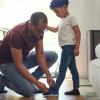
Editor's note: Sponsored by The Bear Creek School.
When today’s parents were kids, American leadership on the global stage was a given. But now we’ve watched our country withdraw from international agreements, enter costly trade wars and alienate long-term allies while botching the response to the largest health crisis in a century. It’s a stark reminder that leadership is about much more than personal ambition or simply being in charge. And it has made many of us more aware than ever of how important it is to prepare our kids to step up to the leadership challenges of the 21st century.
“Training students to be servant leaders is a high value for us. If you’re a servant leader, you’re trying to bring everybody with you by allowing your leadership to ultimately reward the community,” says Kevin Davison, dean of students for The Bear Creek School’s upper school division.
Counter to the pop-culture image of a “born leader” or the idea that some people are just followers, The Bear Creek School, a Christian liberal arts K–12 in Redmond, believes that everyone can learn to be a leader.
“Yes, there certainly are highly charismatic individuals who have the ability to pull people in,” says Davison. But he points out that a lot of different styles of leadership are highly successful. “Leadership is influence. As long as you have influence, you have leadership,” he says. And as long as you are part of a community, you have areas of influence.
In fact, whether leadership involves a formal position of power or not, it is marked by a set of five behavioral practices that make up the leadership curriculum at The Bear Creek School. Drawn from “The Student Leadership Challenge: Five Practices for Becoming an Exemplary Leader” by James Kouzes and Barry Posner, these principles, when bolstered by other social-emotional skills such as communication and empathy, are the means by which leadership can be taught.
1. Modeling
We’ve all heard the phrase “Leading by example,” and at The Bear Creek School, modeling is the first principle of leadership. A leader sets an example by exhibiting the characteristics and habits that they want to encourage in those they hope to lead.
2. Inspiring
Nobody likes to be bossed around. A skillful leader works to inspire a shared vision of what achievement looks like. Thinking more in terms of teamwork than in leader/followers, they allow others to provide feedback and inform the vision. When each person has given input and is invested in the vision, they work more diligently toward it.
3. Challenging
Leaders must be open-minded enough to challenge the processes they are presented with. They shouldn’t be willing to jump through hoops unquestioningly or to simply accept the way things have always been done. By teaching students to have a growth mindset, educators at The Bear Creek School encourage them to always look for ways to improve.
4. Enabling
Enabling is why empathy is more useful than ambition — a good leader recognizes others’ skills and talents and encourages their use. Instead of clinging to control, leaders are willing to share power to empower others’ accomplishments.
5. Encouraging
Since leaders know that achieving a shared vision is more important than receiving personal credit, students are taught to allow others to experience praise — at The Bear Creek School, this is called “encouraging heart.” Young leaders learn to show their appreciation for the contributions of every team member.
Providing leadership opportunities
It’s not necessary to be on the student council to develop as a leader. Participating in clubs and teams, whether in an official role or taking charge of a project or event, also gives students a chance to practice leadership skills. Even helping to keep a group on task during class projects is a form of leadership.
Community service is another important way to lead. That’s because the direct, hands-on involvement required for community service helps to build the empathy and breadth of vision necessary to be a good leader.
What all these opportunities have in common is a chance to have a real effect on outcomes for better — or for worse.
“We spend a lot of time investing in our student leaders to give them an opportunity to actually lead, giving them real power in the school to make decisions and to plan things as well as to risk failure and to actually fail,” says Davison. Creating space to fail is critical because if there’s not a sense that real failure (and its consequences) is possible, kids won’t try as hard to succeed.
Supporting leadership development at home
Whether or not your child’s school puts as much conscious thought into developing leadership skills as The Bear Creek School, the COVID-19 pandemic has changed the learning landscape.
“We try to encourage our students to not take an absolutist thinking on this. We want them to realize there are positives and there are negatives about what’s happening and to allow both emotions to coexist,” says Davison. While the negatives are obvious, the pandemic does give students the opportunity to master new technologies, exercise a growth mindset and lead in creative new ways.
For parents of kids who are learning from home, that may seem counterintuitive. But parents can talk to their kids about the five leadership behaviors in age-appropriate language. They can introduce (and help kids recognize) opportunities to apply those behaviors in their lives. For a kindergartner, that may mean choosing what flavor of ice cream to buy — their choice can make everyone happy or cause someone to be disappointed. For an older kid, it might be a chance to make someone’s life better by planning a community service project to complete during the holidays, or figure out a way to keep a school club from dissolving during remote learning.
Taking healthy risks, overcoming healthy failures
“What we’ve found is that by giving students the ability to do something, and then telling them, ‘The potential for failure is here and failure will mean X, Y and Z,’ they tend to bite into that very strongly and can produce something that’s meaningful, even if it doesn’t always look like what we wanted,” says Davison.
The most important thing parents can do, during the pandemic and after it, is to let kids take risks and experience healthy failure. Too often, parents try to protect kids from the disappointment of failure. And in praising our kids’ successes instead of their efforts, we often unconsciously teach them to only pursue the sure win instead of trying new things.
“I think the most damaging thing we can do as parents is to not encourage our kids to stretch themselves,” says Davison.
Overcoming the fear of failure in order to try new things and developing the ability to learn from failure in order to try again are among the most powerful lessons in leadership — and in life — that we can teach our kids.
|
Sponsored by: |
 " /> " /> |











